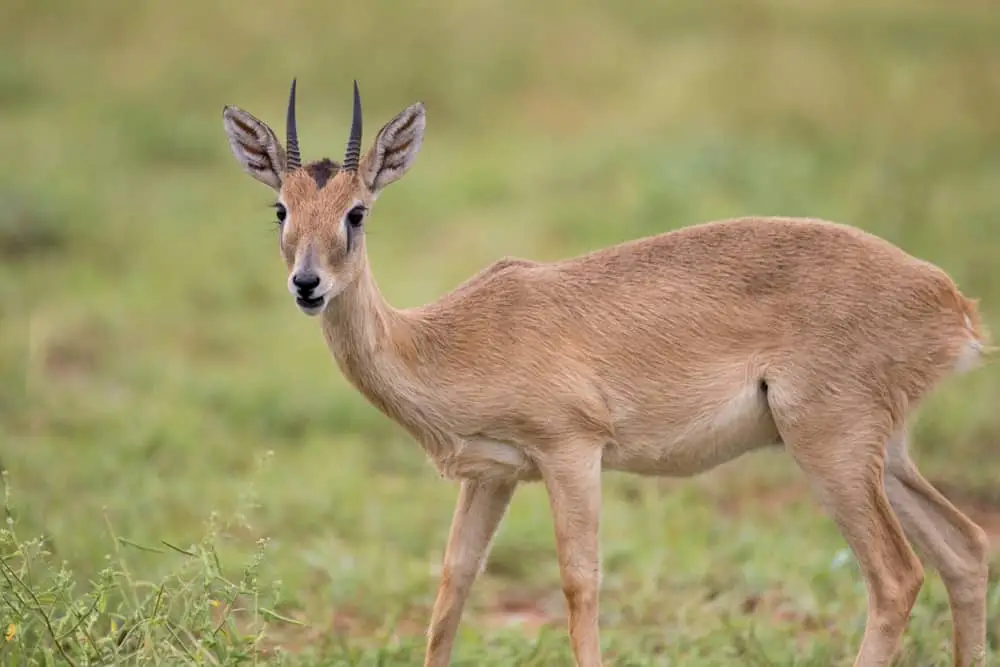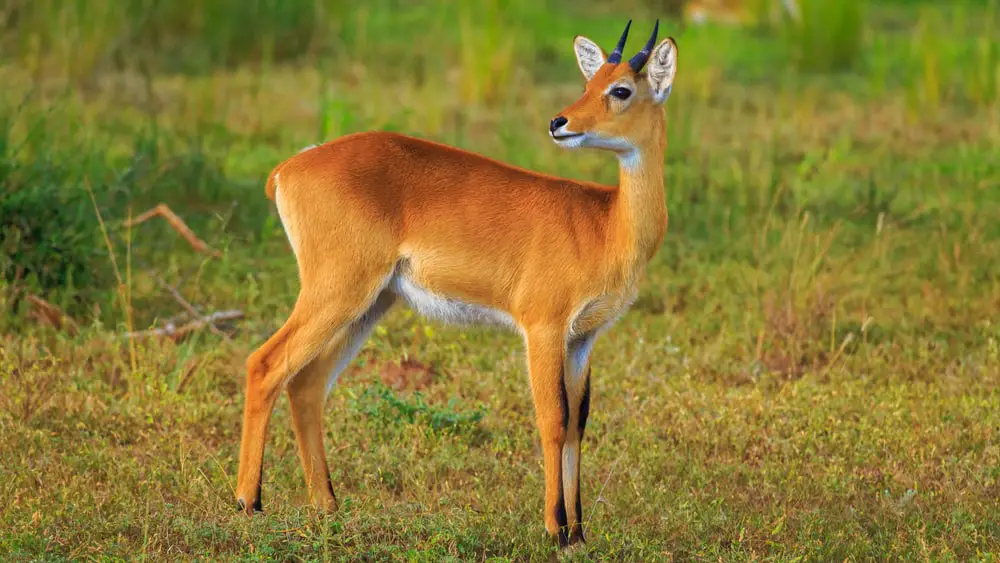The Oribi is a small antelope that inhabits the open grasslands and savannas of South Africa. It has an attractive appearance, with a reddish-brown coat that fades to white on its underside, black legs and facial markings around its eyes. Its unique behavior makes it an interesting subject for study, as it can often be seen grazing in herds or running through tall grasses with incredible speed. This article will explore the physical characteristics, habitat, diet and behavior of the Oribi.
Oribis are well adapted to life in their native habitats. They have powerful hind legs which enable them to make jumps up to five feet high when startled by predators. Their long necks help them reach down into low vegetation for food, while their curved horns serve as protection against other animals. The coloration of their coats helps keep them camouflaged from potential danger while they graze in open areas during the day.
As grazers, oribis consume primarily grasses and shrubs but also eat a variety of fruits depending upon what is available in their particular environment. They travel in herds ranging from 5-20 individuals led by a dominant male who determines where his followers should go next based on seasonal patterns of resource availability. During times of drought or increased predation risk these groups may split apart temporarily until conditions become more favorable again.

Definition
An oribi is a small antelope found in Africa. It has distinctive markings, with white stripes on its back and two black rings around each of its eyes. Oribis are one of the fastest-running antelopes in the world, capable of reaching speeds up to 60 mph (96 km/h). They inhabit open areas such as grasslands or savannas, where they feed mainly on grasses and other low-lying vegetation.
The definition of an oribi can be described as a type of antelope that lives primarily in Africa and is distinguished by having white stripes along its back and black circles around both eyes. Its habitat consists mostly of open plains, like those found in African savannahs, where it grazes on various types of vegetation.
When discussing oribis, it’s important to note their incredible agility and speed; they have been clocked at running up to sixty miles per hour! This remarkable ability allows them to outrun predators while also helping them find food more quickly than many other animals in their environment.
Oribis are adaptable creatures who live in family groups and migrate according to seasonal changes in weather conditions. As a result, they play an important role in maintaining ecological balance within their habitats.
Habitat And Distribution
The Oribi is native to sub-Saharan Africa and has a wide distribution across the continent. Its range covers most countries in this region, from Senegal on the west coast through Ethiopia and Somalia to South Africa on its southern tip. The species can be found in many different habitats, ranging from savannas, grasslands, woodlands, semi-arid bushvelds and coastal wetlands.
Some of the more common locations where oribis are seen include:
- Open grassy plains
- Savanna woodlands
- Coastal wetland areas
Oribis prefer open grassy areas with plenty of shrubs for cover but they also inhabit dry thickets as well as moist lowland forests. Their diet consists mainly of short grasses and leaves but they will occasionally eat fruit or insects when available.
They have an impressive jumping ability which allows them to escape predators quickly. As such, their habitat must provide ample space for them to move around freely without fear of being attacked by other animals or birds of prey.
In order to thrive, oribis require access to adequate food sources and suitable shelter throughout the year; otherwise mortality rates may rise due to predation or malnutrition. In addition to providing sufficient resources, it is important that their habitat remains stable in terms of climate conditions so as not to disrupt their natural behaviour patterns.
Conservation efforts should therefore focus on preserving existing habitats while creating new ones that meet all these requirements if possible.
Characteristics And Behaviour
They possess an interesting set of behaviours likely related to their herbivorous diet; they will often playfully hop around when grazing or rest for short periods during the day. Additionally, these agile creatures commonly engage in acrobatic jumping as part of mating displays or territorial disputes against predators such as cheetahs or wild dogs.
In some cases, they may even stand upright on their hind legs while fighting off potential threats! It is clear that oribi display unique behavioural patterns due to both environmental pressures and social needs.
In general, oribi represent one of Africa’s most remarkable species given their playful nature and ability to adapt quickly to new environments. While they remain vulnerable due to population declines resulting from hunting, conservation efforts continue working to protect this impressive animal throughout East African countries like Kenya and Tanzania.
Diet And Feeding Habits
Oribis, small antelope native to Africa and the Middle East, have a diet that consists of both vegetation and insects. They are insectivorous which means they primarily eat bugs such as locusts and grasshoppers. Oribis also consume leaves, shoots, flowers, fruit, roots and seeds making them omnivores with an emphasis on herbivory.
Their feeding habits depend largely on what is available seasonally in their natural environment due to the availability of foliage or food sources. During wet seasons when plant material is very abundant, oribi will graze mostly on foliage while during dryer months they may rely more heavily on an insectivorous diet for sustenance. When it comes to fruits and seeds these animals take advantage of any opportunity presented by trees or shrubs bearing edible produce.
In general oribis display a varied diet consisting of insects supplemented with a wide range of plants including grasses, herbs and succulents depending upon seasonal availability. This dietary versatility allows them to thrive in many different habitats from open savannahs to densely vegetated forests where other species cannot survive so easily.

Reproduction
The oribi is a small antelope species that exhibits unique mating rituals and reproductive cycles. During the breeding season, which typically takes place in the summer months between May and August for most geographical locations, males engage in loud vocalizations to attract potential mates. The females also engage in similar vocalizations but on a quieter scale than their male counterparts.
Male oribis are known to compete with one another by using aggressive behaviors such as horn fights and wrestling matches. The winner of these competitions will then be able to mate with nearby females. Once mated, female oribis enter into their gestation period or pregnancy lasting around eight months before they give birth to a calf.
Oribis possess well-developed reproductive systems that enable them to reproduce at an efficient rate throughout the year depending on environmental factors such as food availability. Following the birth of their young, mothers must provide parental care until their calves reach independence sometime within six to twelve months after birth. At this stage, calves become fully mature adults ready for reproduction themselves.
Though much remains unknown about the complex mating rituals and reproductive cycle of the oribi species, researchers continue to study this fascinating mammal in hopes of better understanding its behavior and ecology further.
Conservation Status
The oribi is an endangered species. Conservation efforts have been made to prevent further decline in the population of this small antelope. The majority of conservation programs are focused on protecting habitat and improving the quality of protected areas.
Habitat loss is a major threat to the survival of the oribi, particularly due to agricultural activities, urbanization, mining operations, bushmeat hunting and illegal deforestation. To mitigate these threats, various organizations have implemented measures such as buffer zones around nature reserves and protected area management plans that focus on preserving natural habitats for wildlife.
In addition, captive breeding programs have been initiated in some countries in order to maintain genetic diversity among oribis and increase their numbers. Re-introduction projects also aim to re-establish populations into suitable habitats where they can thrive naturally. These initiatives demonstrate a commitment from stakeholders across several sectors towards conserving this threatened species.
Ongoing efforts involve researching ways to reduce human impacts on habitat and improve land use practices which are essential for maintaining viable populations of oribis within their native range. Additionally, education campaigns highlighting the importance of protecting this species may help raise awareness about its plight and garner support for ongoing conservation initiatives.
Interactions With Humans
Oribi have had an ongoing relationship with humans for centuries. They have been hunted, farmed, traded and kept as pets. Oribi-hunting has been a popular activity in many parts of the African continent since ancient times. In some areas there are still traditional hunting ceremonials that involve oribis as part of their cultural practices. The meat from these animals is highly valued for its taste and nutritional value.
In other regions oribis are farmed to produce milk or wool which can then be processed into various products such as clothing, bedding and blankets. This farming also provides employment opportunities to local communities who otherwise may not have access to regular income sources. The trade in oribi hides and skins is also lucrative in certain countries where they are used for leather goods like footwear and handbags.
The popularity of keeping oribis as companions has grown significantly over recent years due to their gentle nature and intelligence. However, it should be noted that this practice increases the risk of poaching activities taking place in order to satisfy demand for pet ownership without proper regulations in place.
It is therefore important for governments and wildlife organizations to monitor such activities closely so that appropriate action can be taken against those found guilty of engaging in illegal trading or poaching of these endangered species.
Overall, interactions between humans and oribi require careful management if we are to ensure sustainable use while protecting this species from becoming extinct. To achieve this goal, stringent laws must be put into effect both nationally and internationally along with increased public awareness about conservation efforts needed to protect oribi populations worldwide
Conclusion
Oribis are an antelope species found in woodland and grassland habitats of sub-Saharan Africa. Despite its small size, the oribi is a unique species with distinct characteristics that separate it from other animals.
Their diet consists mainly of grasses, herbs, shrubs, leaves, buds and flowers. Oribis reproduce through births usually during the wet season when food supply is plentiful. Unfortunately, due to habitat destruction caused by human activities such as agriculture and poaching for their meat or horns, oribi populations have been declining over the years resulting in them being listed on the IUCN Red List as vulnerable species.
Though humans have posed threats to this species’ existence, they can also benefit from interactions with people. Oribis serve as indicators of healthy ecosystems in which vegetation is abundant and predators are scarce; thus aiding conservation efforts by providing valuable information about local environments.
Additionally, oribis help maintain balance within ecosystems by controlling plant population growths through grazing activity. Lastly, these animals provide recreational opportunities for tourists who flock to view wildlife around parks and reserves where oribis reside.
In conclusion, though facing challenges from human interference with their habitats, oribis still remain an integral part of African savanna land biomes and their presence should be preserved for future generations to enjoy. Efforts must be taken to protect their environment so that not only will we continue to appreciate these beautiful creatures but also aid in maintaining ecological stability

